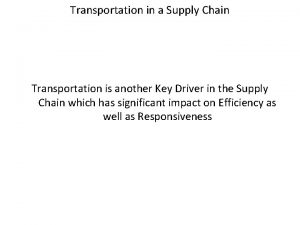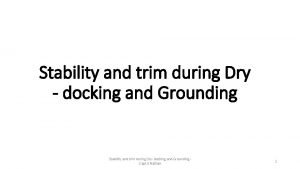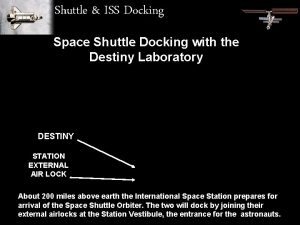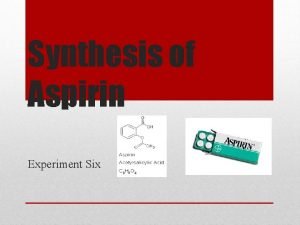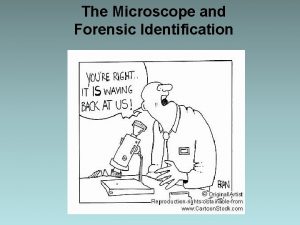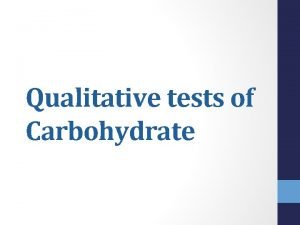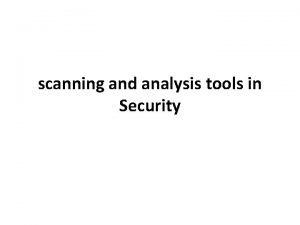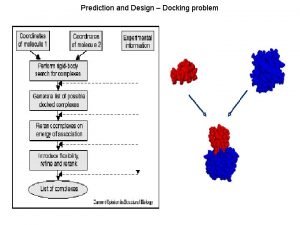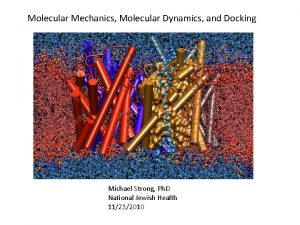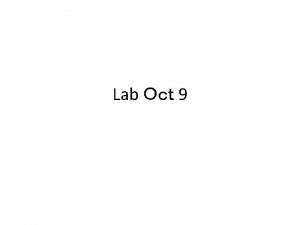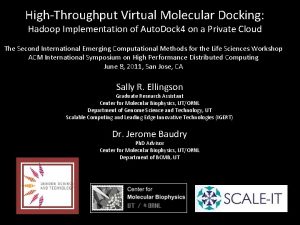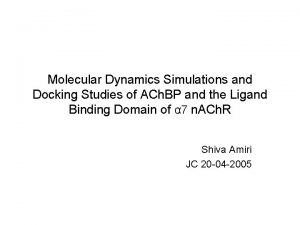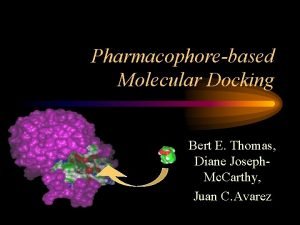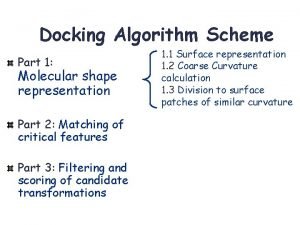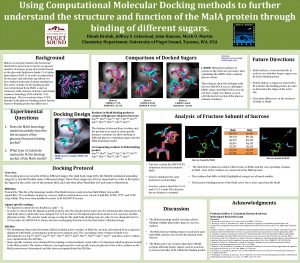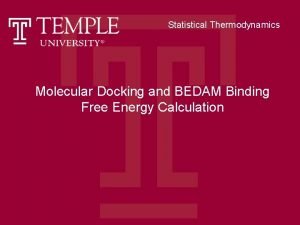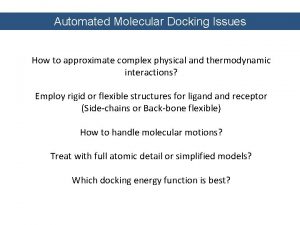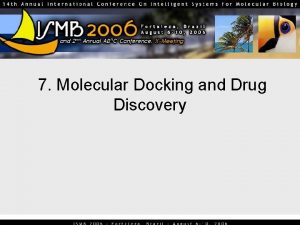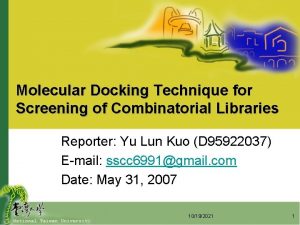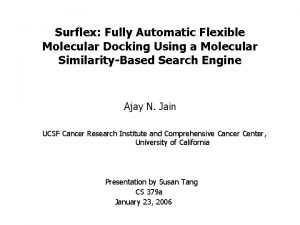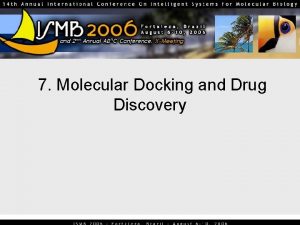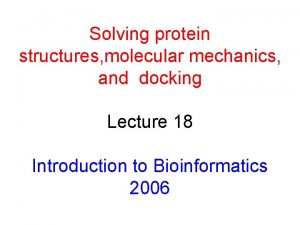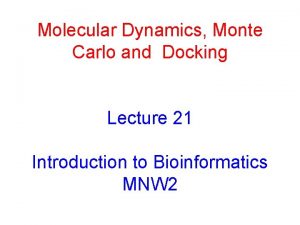Molecular Docking G Schaftenaar Docking Challenge Identification of


























- Slides: 26

Molecular Docking G. Schaftenaar

Docking Challenge • Identification of the ligand’s correct binding geometry in the binding site (Binding Mode) • Observation: – Similar ligands can bind at quite different orientations in the active site.

Two main tasks of Docking Tools • Sampling of conformational (Ligand) space • Scoring protein-ligand complexes

Rigid-body docking algorithms • Historically the first approaches. • Protein and ligand fixed. • Search for the relative orientation of the two molecules with lowest energy. • FLOG (Flexible Ligands Oriented on Grid): each ligand represented by up to 25 low energy conformations.

Introducing flexibility: Whole molecule docking • • Monte Carlo methods (MC) Molecular Dynamics (MD) Simulated Annealing (SA) Genetic Algorithms (GA) Available in packages: Auto. Dock (MC, GA, SA) GOLD (GA) Sybyl (MD)

Monte Carlo • Start with configuration A (energy EA) • Make random move to configuration B (energy EB) • Accept move when: EB < EA or if EB > EA except with probability P:

Molecular Dynamics • force-field is used to calculate forces on each atom of the simulated system • following Newton mechanics, calculate accelerations, velocities and new coordinates from the forces. (Force = mass times acceleration) • The atoms are moved slightly with respect to a given time step

Simulated Annealing Finding a global minimium by lowering the temperature during the Monte Carlo/MD simulation

Genetic Algorithms • Ligand translation, rotation and configuration variables constitute the genes • Crossovers mixes ligand variables from parent configurations • Mutations randomly change variables • Natural selection of current generation based on fitness • Energy scoring function determines fitness

Introducing flexibility: Fragment Based Methods • build small molecules inside defined binding sites while maximizing favorable contacts. • De Novo methods construct new molecules in the site. • division into two major groups: – Incremental construction (Flex. X, Dock) – Place & join.

Placing Fragments and Rigid Molecules • All rigid-body docking methods have in common that superposition of point sets is a fundamental sub-problem that has to be solved efficiently: – Geometric hashing – Pose clustering – Clique detection

Geometric hashing • originates from computer vision • Given a picture of a scene and a set of objects within the picture, both represented by points in 2 d space, the goal is to recognize some of the models in the scene


Pose-Clustering • For each triangle of receptor compute the transformation to each ligand matching triangle. • Cluster transformations. • Score the results.

Clique-Detection • • Nodes comprise of matches between protein and ligand • Edges connect distance compatible pairs of nodes • In a clique all pair of nodes are connected

Scoring Functions • Shape & Chemical Complementary Scores • Empirical Scoring • Force Field Scoring • Knowledge-based Scoring • Consensus Scoring

Shape & Chemical Complementary Scores • Divide accessible protein surface into zones: – Hydrophobic – Hydrogen-bond donating – Hydrogen-bond accepting • Do the same for the ligand surface • Find ligand orientation with best complementarity score

Empirical Scoring parameters fit to reproduce Measured binding affinities (Flex. X, LUDI, Hammerhead)

Empirical scoring DG = DG 0 + DGrot ´ N rot + DGhb + DGio å f (DR, Da ) Loss of entropy during binding Hydrogen-bonding neutral. H -bonds Ionic interactions ionic -int. + DGarom Aromatic interactions arom. int + DGlipo å f (DR, Da ) lipo. cont. Hydrophobic interactions

Force Field Scoring (Dock) é Aij Bij qi q j ù ú = åå ê 12 - 6 + c rij r ij úû i j ê ë rij lig prot Enonbond Nonbonding interactions (ligand-protein): -van der Waals -electrostatics Amber force field

Knowledge-based Scoring Function Free energies of molecular interactions derived from structural information on Protein-ligand complexes contained in PDB Boltzmann-Like Statistics of Interatomic Contacts. [ ] P (s p , s l )= Pref exp - b. F (s p , s l )

Distribution of interatomic distances is converted into energy functions by inverting Boltzmann’s law. F P(N, O)

Potential of Mean Force (PMF) ij æ i ö ( ) s seg r Fij (r ) = - k BT lnçç f. Vol _ corr (r ) ij ÷÷ s bulk ø è s ij seg (r ) ij s bulk Number density of atom pairs of type ij at atom pair distance r Number density of atom pairs of type ij in reference sphere with radius R

Consensus Scoring Cscore: Integrate multiple scoring functions to produce a consensus score that is more accurate than any single function for predicting binding affinity.

Virtual screening by Docking • Find weak binders in pool of nonbinders • Many false positives (96 -100%) • Consensus Scoring reduces rate of false positives

Concluding remarks Scoring functions are the Achilles’ heel of docking programs. False positives rates can be reduced using several scoring functions in a consensus-scoring strategy Although the reliability of docking methods is not so high, they can provide new suggestions for protein-ligand interactions that otherwise may be overlooked
 Positive identification example
Positive identification example Welcome to teen challenge uk - teen challenge uk
Welcome to teen challenge uk - teen challenge uk Physical state of covalent compounds
Physical state of covalent compounds Giant molecular structure vs simple molecular structure
Giant molecular structure vs simple molecular structure Zinc oxide + nitric acid → zinc nitrate + water
Zinc oxide + nitric acid → zinc nitrate + water Receiving and put-away
Receiving and put-away Trystar cable
Trystar cable Alley docking
Alley docking Docking
Docking Protein-protein docking
Protein-protein docking Tailored transportation in supply chain
Tailored transportation in supply chain Cross-docking définition
Cross-docking définition Cdl parallel parking dimensions texas
Cdl parallel parking dimensions texas Dry docking calculations
Dry docking calculations Nas docking station
Nas docking station Walmart cross docking system
Walmart cross docking system Space shuttle iss docking
Space shuttle iss docking Define research problem.
Define research problem. Patient identification checklist
Patient identification checklist Identification of aspirin
Identification of aspirin Boat hin number
Boat hin number Microscope identification
Microscope identification Weed identification
Weed identification Qualitative test of carbohydrate
Qualitative test of carbohydrate Scanning and analysis tools
Scanning and analysis tools Omniverse
Omniverse Business process identification
Business process identification










